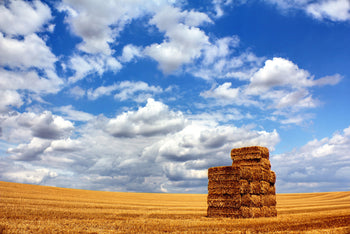
Effectively Storing Hay
With increasing droughts and skyrocketing gas prices, storing hay has become quite costly. Learning to effectively store hay can be a great time and money saver.

Hay, most commonly used as the primary food source for grazing animals such as cattle, sheep, and llamas, is the generic term for dried grass and legume plants. Typically, due to animal stomach sensitivity, hay should be from the same plant group for an entire season, which necessitates storing large quantities of hay through various climates. Hay can be stored in small or large barrels - your decision on barrel size will be impacted by the type of machinery you have which can move large objects. Hay can be best secured in densely-packed barrels with plastic twine, which evades corrosion more so than natural-fiber twine.

Tarps are necessary for both indoor and outdoor hay storage. At Billboardvinyls, we have tarps ranging in sizes to perfectly cover all of your hay barrels.

For indoor storage, tarps should be placed underneath hay to prevent any potential ground wetness from seeping into the bottom of hay barrels, causing it to rot. Because hay is incredibly flammable, it is important to store it with sufficient ventilation. In order to optimize hay shelf life, place newer hay towards the back of the pile, with older hay near the front to be used first.

When storing hay outdoors, tarps must cover the barrels entirely. Sunlight depletes hay of nutritional value, making for ineffective feed. Thankfully, billboardvinyls tarps are UV-resistant. The best stacking method for outdoor storage is in a pyramid so snow and rain can fall easily from the top of the pile.
What size is your hay stack? Billboard vinyls offers several different sizes of tarps perfect for your hay storing needs.
